| |
Friday, November 30, 2007, 12:39 AM GeneralPosted by stefanie Right before I left Washington, I paid one last visit to my fantastic stylist. My hair never looked so good until I started going to Vera (although I had much better stories about the abusive French stylist I saw prior to her), so it was with much sadness and apprehension that I got my last trim. After all, I was leaving her care for a nation composed almost entirely of people with thick, shiny, stick-straight hair. What was a curly-haired girl going to do? Two years is a little long to go without a haircut, even for me (which was a point of contention with the abusive French stylist).
Perms are very popular in Japan, so someone suggested that I find a stylist who cuts permed hair. Fortunately, I was able to find something better. As it turns out, my Japanese teacher's stylist is a Japanese woman with naturally curly hair, which is pretty unusual. Clearly, she was the stylist for me. So, I pushed past the nerves, scheduled an appointment over the phone (Woo-hoo! I made an appointment over the phone!), and got my first haircut in Japan today.
I highly recommend the Japanese haircut. There's lots of head massage action involved, and very close attention to the look of the cut, down to the individual hairs. Also, there's lots of head massage action. It looks and moves like a good cut, though I won't know for sure until I try to do something with it tomorrow. Yay for the J-haircut!
[ 2 comments ] permalink
Saturday, November 24, 2007, 1:05 PM GeneralPosted by stefanie Based on the earlier-than-normal snowfall, it seems that we're in for a long, cold Tohoku winter. At home, we're living under the kotatsu, small space heater at our sides. We wear long underwear to bed and burrow deep within our doubled duck-down kakebuton. The dogs seem to appreciate the heated electric carpet we obtained from a departing expatriate. That's how you know it's really honking cold: the Akita inu, who should be adequately coated for the winter, are digging on the heated carpet. We know it's cold because we can see our breath inside the house when we wake up in the mornings. Yeeks.
The change from Fahrenheit to Celsius exacerbates the feeling of coldness. When I started the car yesterday, the temperature gauge flashed at me: 1.0C, 1.0C, 1.0C. Later, it flashed at me again: 0.5C, 0.5C, 0.5C. These are temperatures slightly above 32 degrees Fahrenheit, which we've clearly experienced, but seeing them expressed in single or fractional digits makes them seem significantly colder. Soon, we'll be in negative temperatures; I wonder if the car will find those flashworthy.
Still, we and other locals continue to travel on our bikes. Yesterday, I saw a guy riding home in the snow, carrying three big daikon in the basket on the front of his bike. There's certainly a different kind of "normal" here than we're used to...
[ 4 comments ] permalink
Friday, November 23, 2007, 2:47 AM GeneralPosted by stefanie and matthew What we're thankful for:
- Friends and family who said, "Go and have fun!"
- Friends and family who added, "And don't forget to come back."
- The "moving crew" of friends and family who helped get everything in storage.
- The neighbor who drove Stefanie to the airport when her taxi didn't show up.
- Small neighborhood restaurants like Funabatei where you can go for really good eats and friendly people who make you feel welcome.
- That Matthew chose to work for James English School instead of Nova.
- Hot coffee in cans from vending machines.
- Sunsets.
- Happy, healthy dogs enjoying our adventure with us.
- A kotatsu.
- Inexpensive organic rice from an English student who is a rice farmer.
- Our new friends here who patiently show us the ropes, tolerate our mistakes, and give us vegetables.
- Nattou.
- Getting back that childlike feeling that the world is full of new and exciting things.
- We've got each other, and that's a lot. (For love, we'll give it a shot!)
Tuesday, November 20, 2007, 9:23 PM GeneralPosted by stefanie One of the charms of small, rural towns in Japan is the public music. In Kitakami, music plays from a central location every day at noon and then again at five, seven, and nine o'clock in the evening. We are told that the music may have been used to help farmers to tell time in the days before watches. Today, it's mostly a lovely thing to hear in daily life ¡½ another of those little touches of "old" Japan. The music differs from place to place. An American who lived in a small town to the north spoke of hearing, among other songs, "Greensleeves" at seven o'clock. Kitakami Yakyoku, or "Kitakami Night Song," is the song we hear everyday. You can hear a sung version of it here.
We've gotten varying stories on when the snow comes to Kitakami. Mostly, we'd been told the first snow is usually near the end of December, or not until January. But another local said it usually snows around the end of November or beginning of December. So we didn't really know what to expect. Yesterday's forecast called for some snow flurries in the middle of the night. So, we were a little surprised that when we went out to meet some friends at 5pm, there was snow already falling, and by the time we returned home, there was even some on the ground. This morning we awoke to six inches of snow on the ground, and big flakes still falling! Eventually the snow got much lighter and the sun came out, so we walked the dogs. 
Saturday Night Cooking Club
Wednesday, November 14, 2007, 6:33 PM GeneralPosted by stefanie Since our first trip to Father Hige's restaurant, we've kind of become regulars there. We'll drop by after work every so often for a drink, some really good cooking, and an animated chat at the bar. On Saturday night, we went there again with some friends. After a couple of hours of joking banter, talk naturally turned to Japanese food. I mentioned that I Ioved cooking, and that as part of my culinary explorations, I was going to begin making nuka-zuke (rice bran pickles) the next day. First, however, I needed to obtain some seaweed to go in the pickling mash. Much to my surprise, Hige-oyaji kindly gave me a big piece of the necessary seaweed, along with a piece of a different type of the same seaweed. He and one of our friends then proceeded to give me a tutorial on cooking nabe (hotpot dishes) with it, complete with little drawings. At the same time, Matthew and another member of our group were involved in an intense discussion about the proper vessel for shio-zuke, or salt pickling. Shio-zuke, our companions had explained, is the traditional Tohoku pickling technique ¡½ rice bran pickling is more common in the Kanto (greater Tokyo area, generally) and Kansai (area including Kyoto and Osaka) regions. Wooden tubs are needed for proper salt-pickling because they encourage the right kind of fermentation. Using a synthetic tub just gets you salty vegetables. Today, the nuka-zuke bed is in its fourth day of development. Thanks to our friends, we'll also be exploring shio-zuke and nabe soon.
Friday, November 2, 2007, 3:56 AM GeneralPosted by matthew Is there anything you're planning to do "someday"?
Last May, we traveled to northern Japan. It was an amazing experience, and afterwards we sometimes talked about the possibility of moving there. Then, in October, we decided we would actually do it — "someday".
That "someday" was comforting. No hurries, nothing that needed to be done right then. We had plenty of time to get our affairs in order, save money, and prepare ourselves. We were able to think of ourselves as bold, adventurous people — "We made this momentous decision!" — without having to actually do anything about it.
Just a few days later, a year ago today, everything changed. Life presented us with a crossroads, and forced us to make a choice. It was time to really commit, if we were seriously going to do this.
But what if that hadn't happened? Where would we be today? Would we still be in Maryland, making our plans to move to Japan "someday"? Would that "someday" ever have come?
If we could do something when we had to make a choice, why couldn't we do it without life forcing the issue? What were we waiting for?
What are you waiting for?
[ add comment ] permalink
Friday, November 2, 2007, 3:20 AM GeneralPosted by stefanie "If you're gonna jump, then jump far." ¡½ Natasha Bedingfield, contemporary British philosopher
Having a comfortable life means having a place to stand, and room to maneuver. It means walking around, dodging obstacles, and sitting down with a drink in your hand at the end of the day. It means home, stability, refuge. You might go near the edge, but you don't jump.
But when the ground starts to crumble under your feet, you have two options. You can step back to safety, or you can jump.
One year ago today, we decided to jump.
[ 3 comments ] permalink
On Sunday, we took advantage of the fine fall weather to make an excursion on the Kitakami Line. This railroad crosses the central mountains of Japan, traveling between Kitakami and Yokote (in Akita Prefecture). Running along steep hillsides and across mountain valleys, it offers spectacular views — especially in autumn, when the leaves are changing. In Kitakami, some fall colors are starting to show, but as we ascended it became clear the leaves were much further along in the mountains. Exiting the first tunnel into a mountain valley, the change in view was so startling that everyone on the (somewhat crowded) train gasped. 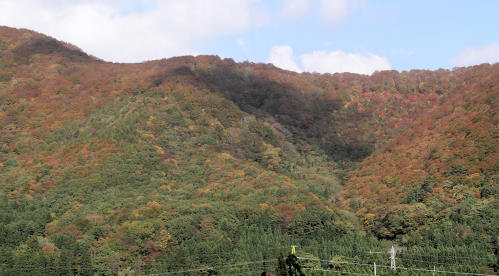 We were in and out of tunnels most of the way, with plenty of breathtaking scenery in between. Sometimes the colors were brightest on the hillside near the train. 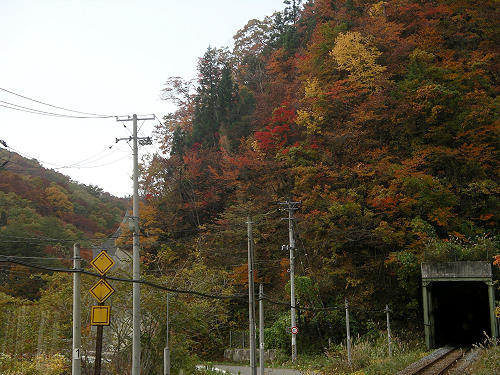 Other times, it was the view across a valley that was spectacular. 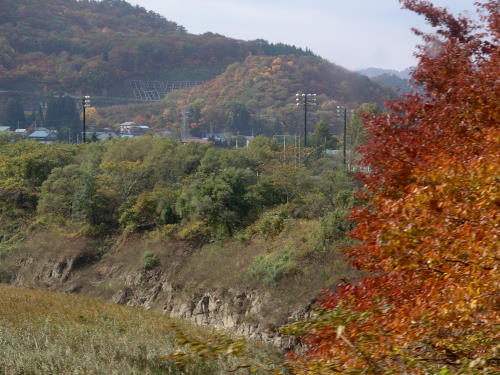 At the end of the line, we took a couple of hours to walk around Yokote. Brightly colored trees shared the view with Yokote Castle. 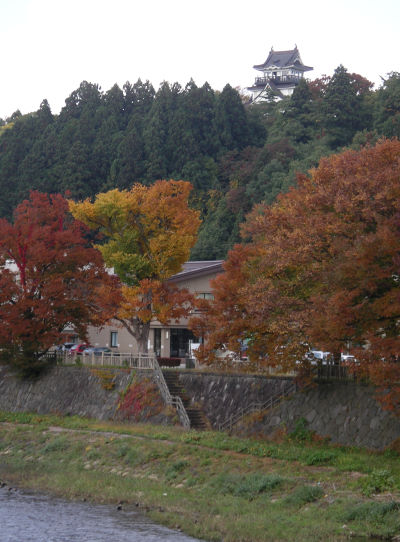 We left Yokote in the early afternoon so we'd have time to stop in Hotto Yuda, an onsen (hot spring) village along the way. There's even an onsen inside the railroad station! The town is on the shores of a mountain lake, in an area justly famous for the turning leaves. 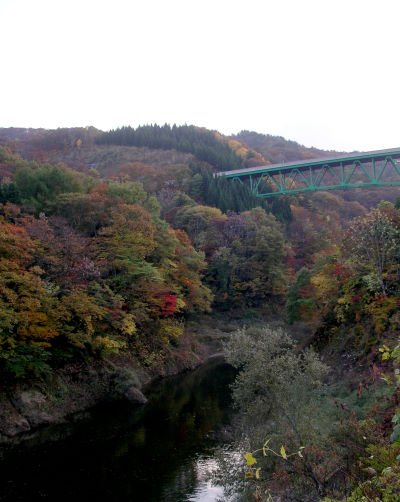 We enjoyed a soak in the spring (more on that later), then returned home, refreshed but exhausted.
Wednesday, October 31, 2007, 1:57 AM GeneralPosted by stefanie Public baths can be daunting to foreigners because of the language barrier and the unwritten etiquette. We visited plenty of public baths during our vacation last year, but I still get nervous about inadvertently breaking one of the rules. And my nascent language skills aren't quite up to the challenge of conversing about the finer points of public bathing. So our Sunday onsen (hot spring bath) visit left me feeling both extra clean and a bit confused.
We know the public bath drill. First, you wash your hair and body at a separate wall of spigots, using a large washcloth. After washing, you can soak as long as you like in the hot baths. Once you're done bathing, you shower off again before returning to the dressing room. It's all very civilized and quite enjoyable after you get past the "roomful of naked people" aspect.
I followed the drill: washing, soaking, contemplating. When I felt adequately onsened, I headed back to the spigots, but my spot near the soap was occupied. No matter. I figured I'd cool off with a soap-free rinse at another spigot. The woman next to me offered me some of soap she had brought. I told her that I was quite daijoubu, but thanks. And then she offered the soap again, with a kind (tolerant?) smile and a "kudasai."
Crap. "Kudasai" always makes me nervous because it's used for requests and I often don't know how to read the request. Did she mean "please, feel free to use my soap"? Or did she mean "No, seriously, it's completely unacceptable to not use soap after bathing. Don't you know the rules?" Not wanting to offend, I gave a very formal thank you and lathered up my oversized washcloth, desperately trying to remember whether I was supposed to use soap after soaking in the bath.
Next time, I'm taking my own soap.
[ 3 comments ] permalink
Back Next
|
|






 Calendar
Calendar




